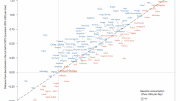The El Niño climate cycle has been responsible for widespread simultaneous crop failure in different regions of the world, a study has found, putting pressure on countries to prepare for future weather events.
A paper published in ScienceAdvances showed that the El Niño Southern Oscillation, a warm water wave that travels across the Pacific every three to five years, causes a variety of irregular weather patterns, which affect crops worldwide.
The findings contradict the long-held assumption that crop failures in geographically distant breadbasket nations such as the United States, China and Argentina are unrelated, according to the International Food Policy Research Institute, a partner in the research.
“Knowing the chances of getting high or low yields can greatly help farmers to adjust crop management decisions for the coming season,”
Walter Baethgen, scientist, Columbia Earth Institute
Researchers also looked at the effect of the Indian Ocean Dipole, or Indian Niño, and other climate patterns on crops.
They found that maize, or corn, was the most susceptible to crop failure, with climate variability causing 18 per cent of growth volatility globally between 1980 and 2010. Soy bean and wheat were less at risk, with climate variability accounting for seven per cent and six per cent of year-to-year changes in yields respectively.
To understand El Niño’s impact on crops, the team from the International Research Institute for Climate and Society at Columbia University in the United States analysed earlier climate models of El Niño and compared this with data on crop harvests.
El Niño shifts the growing season around the tropics, causes winter drought in Africa and South America, and changes the timing of monsoon rainfalls in Asia.
The study showed that El Niño can result in simultaneous crop failures in different parts of the world, with certain regions particularly at risk. Looking at maize, the phenomenon caused 38 per cent of production variance in northeast Brazil, 20 per cent in southwest Mexico and 15 per cent in West Africa.
Authors of the report say their findings show the potential for mitigating such climate risks.
Walter Baethgen, a scientist at Columbia’s Earth Institute and co-author of the study, said: “Knowing the chances of getting high or low yields can greatly help farmers to adjust crop management decisions for the coming season such as planting dates, fertiliser use and deciding what crops to be planted.”
Baethgen and his colleagues hope the results will encourage governments and international bodies concerned with food security to develop plans to deal with food shortages. “[They] can use the information on the probability of expected good or bad harvests around the world to improve their climate risk management, by establishing early warnings and early actions,” he said.
South and Central America are particularly strongly influenced by El Niño and this can have both negative and positive consequences for crops, the study showed. During an El Niño phase, the eastern side of South America experiences extra rain and cloudiness, which leads to above-normal yields for maize and soybean but also an increased risk of diseases in wheat varieties.
Oscar Rojas, a natural resources officer at the Food and Agriculture Organization’s climate and environmental division, studies the impact of El Niño on central and southern America. He says better understanding of the phenomenon’s effect on crops could help farmers diversify to more adaptable crops such as tuber vegetables or sorghum, and adopt farming practices to cope with fluctuating weather patterns.
“They should prefer short-cycle varieties instead of long-cycle that would have more chance to be affected by drought,” he said. “Zero tillage is recommended to avoid high evaporation and transpiration in their plot.”
Sea surface temperature patterns in the tropical Pacific Ocean were at borderline to weak El Niño levels in April and early May 2019 and the likelihood of a strong El Niño this year appears low, according to the World Meteorological Organization.
The phenomenon, which is only just starting to be understood, is likely to change as global warming intensifies. Some scientists predict that El Niño might concentrate in the Pacific without traversing its lengths, while others suggest its pattern may become less predictable.
Weston Anderson, also a researcher at Columbia and co-author of the study, says the model can still be helpful in the face of climate change, as it details the physical mechanisms that cause crop failures during an El Niño.
“[This] puts us in a good position to continue making and using seasonal climate forecasts even if the characteristics of El Niño change as the climate changes,” he said.
By Inga Vesper
July 15th, 2019
This article was originally published on SciDev.Net. Read the original article.




